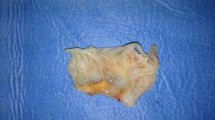Summary
Light and electron microscopic morphometry was carried out in tissue samples which were obtained from the left ventricular free wall in 29 patients with chronic aortic valve disease during open-heart surgery. 6 patients had aortic stenosis, 9 had aortic insufficiency and 14 had a mixed aortic valve lesson. Hemodynamics were studied before operation. Patients with mixed aortic valve disease had a higher left ventricular mass, a lower ejection fraction and mean circumferential fiber shortening rate than patients with aortic stenosis. Peak systolic wall stress was comparable between groups. The intracellular content of contractile material was lower and the sarcoplasmic volume was higher in mixed aortic valve disease than in aortic stenosis. Mitochondrial volume and interstitial fibrosis were not different between groups. Patients with aortic insufficiency showed no significant difference of parameters as compared to both other groups. We conclude that an intracellular deficiency of myofibrils causes lack of contractility in advanced hypertrophy due to mixed aortic valve disease.
Zusammenfassung
Licht- und elektronenoptische Morphometrie wurde an Gewebeproben des linken Ventrikels durchgeführt, die bei der Herzoperation entnommen wurden. 6 Patienten hatten eine Aortenstenose, 9 eine Aorteininsuffizienz und 14 ein kombiniertes Aortenvitium. Hämodynamische Messungen wurden vor der Operation durchgeführt. Patienten mit kombiniertem Aortenvitium hatten eine höhere linksventrikuläre Masse, eine niedrigere Ejektionsfraktion und Verkürzungsgeschwindigkeit als Patienten mit Aortenstenose. Der systolische “Wall Stress” war vergleichbar in den 3 Gruppen. Der intrazelluläre Gehalt an Myofibrillen war geringer, und der sarkoplasmatische Raum war höher bei kombinierten Aortenvitien als bei Aortenstenose. Das Mitochondrienvolumen und die interstitielle Fibrose waren nicht unterschiedlich in den Gruppen. Patienten mit Aorteninsuffizienz zeigten keinen signifikanten Unterschied zu den beiden anderen Gruppen. Wir schließen daraus, daß eine intrazelluläre Verarmung von kontraktilem Material die Ursache der eingeschränkten Myokardfunktion bei fortgeschrittener Hypertrophie infolge kombinierten Aortenvitiums ist.
Similar content being viewed by others
References
Linzbach, A.J.: Heart failure from the point of view of quantitative anatomy. Amer. J. Cardiol.14, 370–382 (1960).
Maron, B.J., V.J. Ferrans, W.C. Roberts: Myocardial ultrastructure in patients with chronic aortic valve disease. Amer. J. Cardiol.35, 725–739 (1975).
Schwarz, F., W. Flameng, J. Schaper, F. Langebartels, M. Sesto, F. Hehrlein, M. Schlepper: Myocardial structure and function in patients with aortic valve disease and their relation to postoperative results. Amer. J. Cardiol.41, 661–669 (1978).
Hunt, D., W.A. Baxley, J.W. Kennedy, T.P. Judge, J.E. Williams, H.T. Dodge: Quantitative evaluation of cineaortography in the assessment of aortic regurgitation. Amer. J. Cardiol.31, 696–700 (1973).
Kasser, I.S., J.W. Kennedy: Measurement of left ventricular volumes in man by single-plane cineangiography. Invest. Radiol.4, 83–90 (1969).
Trenouth, R. S., N. C. Phelps, W. A. Neill: Determinants of left ventricular hypertrophy and oxygen supply in chronic aortic valve disease. Circulation53, 644–650 (1976).
Schwarz, F., W. Flameng, J. Thormann, M. Sesto, F. Langebartels, F. Hehrlein, M. Schlepper: Recovery from myocardial failure after aortic valve replacement. J. Thorac. Cardiovasc. Surg.75, 854–864 (1978).
Weibel, E. R., S. K. Gonzagne, F. Walter: Practical stereological methods for morphometric cytology. J. Cell. Biol.30, 23–38 (1966).
Hatt, P. Y., P. Jouannot, J. Moravec, J. Perennec, M. Laplace: Development and reversal of pressure induced cardiac hypertrophy. Light and electron microscopic study in the rat under temporary aortic constriction. Basic Res. Cardiol.73, 405–421 (1978).
Wigle, E. D.: Myocardial fibrosis and calcareous emboli in valvular heart disease. Brit. Heart J.19, 539–549 (1957).
Author information
Authors and Affiliations
Additional information
Paper, presented at the Erwin Riesch Symposium, Tübingen, April 3–7, 1979
With 3 figures and 2 tables
Rights and permissions
About this article
Cite this article
Schwarz, F., Kittstein, D., Winkler, B. et al. Quantitative ultrastructure of the myocardium in chronic aortic valve disease. Basic Res Cardiol 75, 109–117 (1980). https://doi.org/10.1007/BF02001402
Issue Date:
DOI: https://doi.org/10.1007/BF02001402



